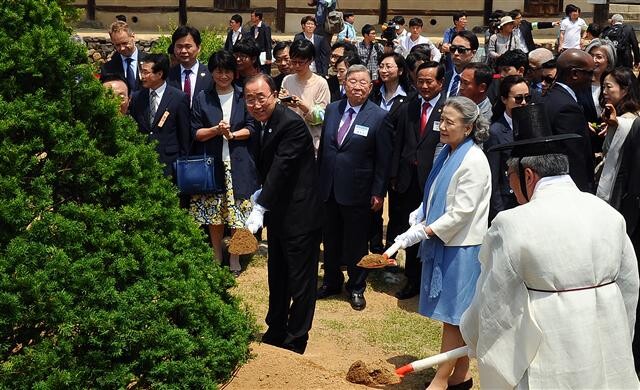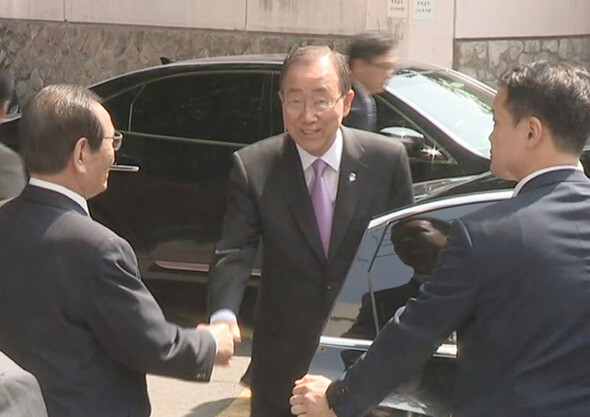hankyoreh
Links to other country sites 다른 나라 사이트 링크
Ban Ki-moon’s weekend tour hints even more strongly at presidential run

Over the May 28 and 29 weekend, UN Secretary-General Ban Ki-moon took steps that were overtly political. He met Kim Jong-pil, a former prime minister and leading politician from the Chungcheong region, and he visited North Gyeongsang Province, a political stronghold of the ruling Saenuri Party. This is causing pundits to conclude that the entire purpose of Ban’s visit to South Korea was to underscore his status as a presidential candidate.
Unabashedly political behaviorWhen Ban visited the Hahoe Folk Village in Andong, North Gyeongsang Province, on May 29, there was a banner hanging from the entrance that depicted Ban’s beaming face. As Ban got out of the car, he was met by Kim Gwang-rim, chair of the policy committee for the Saenuri Party and the lawmaker representing the area in the National Assembly.
After planting a commemorative tree at Chunghyodang, the ancestral home of Ryu Seong-ryong, who served as Korea’s Chief State Councillor when the Japanese invaded at the end of the 16th century, Ban said, “I made this visit to remember Ryu Seong-ryong’s devout love for his country and his commitment to serving his country and with the hope that we will all work for the development of this country.” He also wrote a message along the same lines in the visitor’s book. When a reporter asked if this was related to a presidential bid, Ban’s only response was a smile.
After having a luncheon with North Gyeongsang Province Governor Kim Gwan-yong and Kim Gwang-rim, Ban paid an unscheduled visit to the new North Gyeongsang Provincial Office, located five minutes away from Hahoe Folk Village. In the evening, Ban headed to Gyeongju where he attended a welcome dinner for an NGO conference. In the space of a day, Ban had visited two locations in North Gyeongsang Province, the support base of the Saenuri Party.
Ban’s behavior on the previous day raised even more eyebrows. On the morning of May 28, Ban, who was born in Eumseong, North Chungcheong Province, paid an unexpected visit to the house of Kim Jong-pil in Seoul. Just three days after strongly hinting at a presidential run with the revelation that he was mulling over what role he should play next year as a South Korean citizen, Ban met Kim, one of the best-known politicians from the Chungcheong region.
Many political analysts had assumed that Ban would not meet Kim out of concern for the political interpretations this might suggest, including a presidential run relying on the Chungcheong vote. But it turns out that it was Ban who proposed the meeting with Kim.
Ban and Kim had a 30-minute conversation without anyone else present. After the meeting, Ban told reporters that he had “visited Kim because he was an elder statesman and a senior colleague.” When asked whether he and Kim had discussed the presidential election or the chances of a Chungcheong candidate, Ban said, “We didn’t talk about that.” But Kim pointedly remarked that they had also shared some “secrets.”
Ban has reportedly gotten advice from Kim in the past when confronting important issues.
“Most people from the Chungcheong region who have wanted to enter politics have gone to see Kim, who is the symbolic leader of the region. Ban would have had no reason to meet Kim unless he was confirming a presidential run,” said Lee Jun-han, a professor at Incheon National University.
That evening, Ban had dinner for about two-hours at the Lotte Hotel in Seoul with about 14 heavyweights in the areas of politics, business and the media, including former prime ministers Goh Kun, Roh Shin-yeong, Lee Hyun-jae, and Han Seung-soo; Shin Dong-bin, chairman of the Lotte Group; and Kim Dae-jung, an advisor for the Chosun Ilbo newspaper. Participants in the meeting would only say that they mostly talked about Ban’s activity in the UN and did not discuss the presidential campaign or domestic politics. Roh Shin-yeong is regarded as Ban’s mentor.

Many political observers are surprised by how blatant Ban’s actions have been, as well as by their speed and elaborate preparation.
“Ban appears to have visited South Korea with the apparent purpose of announcing his presidential candidacy. With the Saenuri Party devoid of presidential candidates after the bloodbath in the general elections, Ban seems to be hoping to get a head start by putting the spotlight on himself,” said one Saenuri Party lawmaker from Seoul.
“There are three stages in the presidential campaign schedule: candidates prepare for their run through the end of this year, the party primaries will run until next July and the main campaigning takes place between next August and December. The best strategy for Ban is to announce that he will be running in next year‘s election now, while we are still in the first stage,” said Kim Hyung-joon, professor at Myongji University.
“If the Saenuri Party had been victorious in the general elections, Ban would have delayed the announcement of his run until the beginning of next year, but he appears to have moved his schedule forward because of the changing circumstances,” Kim said.
Analysts also believe that Ban is on board with a strategy drafted by some members of the faction of the Saenuri Party aligned with President Park Geun-hye to focus on TK (referring to Daegu and North Gyeongsang Province) along with the Chungcheong region.
“It’s no longer a toss-up whether Ban will run for president. I think the chances are up to 60 or 70%,” said Jeong Woo-taek, a lawmaker from North Chungcheong Province. “I think his meeting with Kim Jong-pil and his visit to Andong and Gyeongju in North Gyeongsang Province were intended to send a message about focusing on TK and Chungcheong.”
Some analysts also think that Ban may have run these plans by the Blue House. Ban‘s aggressive moves occurred while President Park was visiting Africa and France.
“The Blue House may have indicated to Ban that it will hand the mantle to him as a means of maintaining order in the party and the current power structure after the defeat in the general elections, and Ban may have consented to this,” said Shin Yul, professor at Myongji University.
But there is also widespread concern about the sudden boldness of Ban’s political gestures. Criticism is particularly concentrating on behavior that appears to rely on regional sentiment.
“The person who is the leader of the UN, which is an international organization, chose to meet with Kim Jong-pil to provoke regional sentiment about basing a presidential run on Chungcheong. The same person is also counting on regional allegiance with his visits to locations in North Gyeongsang Province. This is a classic example of old-style politics,” said a Saenuri Party lawmaker from Seoul.
Saenuri Party Secretary-General Hong Moon-pyo is eager to recruit Ban as the party’s presidential candidate, but even he is wary about stressing the Chungcheong connection too much. “We should hold back on this, since if we go too far it could backfire,” Hong said.
There are also concerns that, if Ban jumps into the race too soon, he could expose himself to scrutiny early on. Ban might also be marginalized as a “pro-Park candidate” if the political winds shift in the future.
By Kim Il-woo, Daegu correspondent in Andong
Please direct questions or comments to [english@hani.co.kr]

Editorial・opinion
![[Column] Season 2 of special prosecutor probe may be coming to Korea soon [Column] Season 2 of special prosecutor probe may be coming to Korea soon](https://flexible.img.hani.co.kr/flexible/normal/500/300/imgdb/original/2024/0426/3317141030699447.jpg) [Column] Season 2 of special prosecutor probe may be coming to Korea soon
[Column] Season 2 of special prosecutor probe may be coming to Korea soon![[Column] Park Geun-hye déjà vu in Yoon Suk-yeol [Column] Park Geun-hye déjà vu in Yoon Suk-yeol](https://flexible.img.hani.co.kr/flexible/normal/500/300/imgdb/original/2024/0424/651713945113788.jpg) [Column] Park Geun-hye déjà vu in Yoon Suk-yeol
[Column] Park Geun-hye déjà vu in Yoon Suk-yeol- [Editorial] New weight of N. Korea’s nuclear threats makes dialogue all the more urgent
- [Guest essay] The real reason Korea’s new right wants to dub Rhee a founding father
- [Column] ‘Choson’: Is it time we start referring to N. Korea in its own terms?
- [Editorial] Japan’s rewriting of history with Korea has gone too far
- [Column] The president’s questionable capacity for dialogue
- [Column] Are chaebol firms just pizza pies for families to divvy up as they please?
- [Column] Has Korea, too, crossed the Rubicon on China?
- [Correspondent’s column] In Japan’s alliance with US, echoes of its past alliances with UK
Most viewed articles
- 1No good, very bad game for Korea puts it out of Olympics for first time since 1988
- 2[Column] Season 2 of special prosecutor probe may be coming to Korea soon
- 3Korea’s 1.3% growth in Q1 signals ‘textbook’ return to growth, says government
- 4‘We must say no’: Seoul defense chief on Korean, USFK involvement in hypothetical Taiwan crisis
- 5Is N. Korea threatening to test nukes in response to possible new US-led sanctions body?
- 6Division commander ordered troops to enter raging flood waters before Marine died, survivor says
- 7[Column] ‘Choson’: Is it time we start referring to N. Korea in its own terms?
- 8Will NewJeans end up collateral damage in internal feud at K-pop juggernaut Hybe?
- 9Korea sees more deaths than births for 52nd consecutive month in February
- 10[Editorial] Korea’s surprise Q1 growth requires objective assessment, not blind fanfare